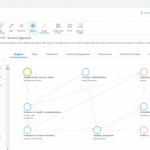How Low-Code Drives Digital Transformation
April 15, 2025
Businesses are investing in the digital future and many companies are aiming for digital transformation. Maximizing the business is not only about enabling a bunch of tools to automate routine processes. Business owners should also consider implementing a digital strategy fully integrated into business operations at all levels.
Table of Contents
Why your company needs digital transformation
Digital transformation is viewed as a way to apply modern technologies for understanding the customers’ needs.
This is one reason, but digital transformation can help achieve much more:
- Reinforced data collection Companies are gathering loads of different data on customers. But the information needs to be optimized for analysis to drive the business forward.
- Better resource management Digital transformation accumulates company resources in one place and provides a set of tools for a consistent experience.
- Data-driven insights and decisions Data makes strategies more agile, flexible, and relevant to the current situation on the market.
What is low-code?
Enterprises are searching for the easiest and most effective way to empower digital transformation with no coding effort.
The low-code approach utilizes a set of tools. It replaces classical app development with modeling in a graphical interface, skipping hand-coding. It helps to maximize ROI from the currently existing tech stack. Such applications connect data from various sources, and allow non-IT users to act on it and build new features which help businesses to “meet the moment”.
The next question which comes to mind is what is low-code development?
It’s a visual approach to software development. It allows to easily automate each stage of the development lifecycle.
And finally, what is a low-code platform? It’s a framework that provides a programming environment for building and configuring software via graphical UI. The basic elements help detach from the code and “draw” the workflow.
Technical features
- Drag-and-drop Functionality is used to create an entire app from scratch.
- Visual Interfaces allow quick design and implement a solution using model-driven environments and custom rules. No hand-coding is involved.
- Multi-Platform Experience. The desktop version is convenient to build and design an application that afterward can be quickly launched on any mobile device.
- Repeatable Applications. It’s possible to efficiently reuse pre-existing apps or their parts to configure similar processes.
Advantages of utilizing low-code
Most importantly, it is a way to accelerate product development. It is vital in the digital era when businesses have to evolve and compete fiercely to meet customers’ expectations.
Low-code tools allow non-IT staff to create customized solutions that cover the everyday needs of the company. On the other hand, professional development teams can adopt low-code to create apps or enrich the existing ones with new features in a blink of an eye.
Now we’ve figured out what low-code development and platforms are. It is clear they have enormous potential but what are the best options for businesses to solve daily tasks? This is where intelligent business process management (BPM) comes in handy.
What is iBPM?
iBPM empowers collaboration through the entire enterprise including employees, partners, applications, and systems.
Let’s take a closer look at the key components of BPM. Intelligence in BPM has numerous forms: setting up business rules, configuring virtual assistants, data mining, and structuring. A proper BPM solution can fully automate recurring tasks.
An iBPM platform is capable of modeling, executing, and monitoring all routine processes.
iBPM is more than just a modern technology or a buzzword. iBPM software radically changes all business processes and fuels digital transformation. The tool guides business process management. Also integrates it with project management, CRM systems, people management, and every other tool the company needs to use. As a result, all operations are tracked and performed on a single platform. All company departments have common standards, pre-defined by iBPM. Thus, the transition to digital is simultaneous.
Conclusion
Low-code is an important part of the innovation agenda. The benefits rapidly change the overall IT strategy. It enables the fast build and deployment of business software. An app can be kicked off in a matter of weeks. New functionality can be deployed much faster with a truly agile approach to software development.
Low-code iBPM systems are meant to facilitate digital transformation. Non-IT personnel is capable to set and optimize processes. Companies can reach business objectives without the support of complicated development.


